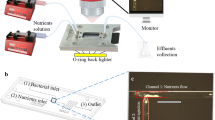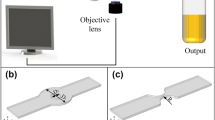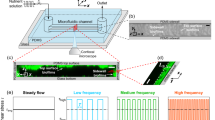Abstract
Biofilms form an irregular network matrix that is surrounded by extracellular polymeric substrate (EPS). The architecture of biofilm plays an important role in protecting bacteria under physical, chemical, and biological stress. The shear stress is one of the major factors to construct stable bioflim. The experimental observation of biofilm formation on large-scale water flow has been limited because most of fluid pipe are water and sewer lines. This study presents the biofilm formation in a PDMS-based microfluidic channel which is able to simulate fluid pipes at small scale. We could characterize the hydrodynamics of the growth of single-species bacteria between biofilm formation and the external environmental factors. Particularly, the dynamics of biofilm formation confirms that biofilm, under the optimum shear stress, efficiently form a stable EPS structure which provides a mechanical shield against high-pressure fluidic flow.
Similar content being viewed by others
References
Zobell, C.E. The effect of solid surfaces upon bacterial activity. J. Bacteriol. 46, 39–56 (1943).
Kim, K.P. et al. In situ monitoring of antibiotic susceptibility of bacterial biofilms in a microfluidic device. Lab. Chip. 10, 3296–3299 (2010).
Biering-Sorensen, F. Urinary tract infection in individuals with spinal cord lesion. Curr. Opin. Urol. 12, 45–49 (2002).
Sauer, K. Pseudomonas aeruginosa displays multiple phenotypes during development as a biofilm. J. Bacteriol. 184, 1140–1154 (2002).
Costerton, J.W. Introduction to biofilm. Int. J. Antimicrob. 11, 217–221 (1999).
Campodónico, V.L. et al. Airway epithelial control of Pseudomonas aeruginosa infection in cystic fibrosis. Trends Mol. Med. 14, 120–123 (2008).
Lechtzin, N. et al. Outcomes of adults with cystic fibrosis infected with antibiotic-resistant Pseudomonas aeruginosa. Respiration 73, 27–33 (2006).
George, A.M. & Levy, S.B. Amplifiable resistance to tetracycline, chloramphenicol, and other antibiotics in Escherichia coli: involvement of a non-plasmid-determined efflux of tetracycline. J. Bacteriol. 155, 531–540 (1983).
Nikaido, H. The role of outer membrane and efflux pumps in the resistance of gram-negative bacteria. Can we improve drug access? Drug Resistance Updates 1, 93–98 (1998).
Pratt, L.A. & Kolter, R. Genetic analyses of bacterial biofilm formation. Curr. Opin. Microbiol. 2, 598–603 (1999).
Stoodley, P. Biofilms as complex differentiated communities. Annu. Rev. Microbiol. 56, 187–209 (2002).
Hatch, R.A. & Schiller, N.L. Alginate lyase promotes diffusion of aminoglycosides through the extracellular polysaccharide of mucoid Pseudomonas aeruginosa. Antimicrob. Agents Chemother. 42, 974–979 (1998).
Souli, M. & Giamarellou, H. Effects of slime produced by clinical isolates of coagulase-negative staphylococci on activities of various antimicrobial agents. Antimicrob. Agents Chemother. 42, 939–941 (1998).
Chen, G.A. et al. Strategy for antagonizing quorum sensing. Mol. Cell. 42, 199–209 (2011).
Davies, D.G. The involvement of cell-to-cell signals in the development of a bacterial biofilm. Science 280, 295–298 (1998).
Shim, H. et al. Patterning of proteins and cells on functionalized surfaces prepared by polyelectrolyte multilayers and micromolding in capillaries. Biosensors and Bioelectronics 22, 3188–3195 (2007).
Jeong, H. et al. Biofilms microfluidic monitoring of Pseudomonas aeruginosa chemotaxis under the continuous chemical gradient. Biosensors and Bioelectronics 26, 351–356 (2010).
Cheng, C.M. & LeDuc, P.R. Micropatterning polyvinyl alcohol as a biomimetic material through soft lithography with cell culture. Mol. BioSyst. 2, 299–303 (2006).
Lin, K. et al. Molecular mechanism of endothelial growth arrest by laminar shear stress. Proc. Natl. Acad. Sci. USA 97, 9385–9389 (2000).
Balaban, N.Q. et al. Bacterial persistence as a phenotypic switch. Science 305, 1622–1625 (2004).
Aaron, S.D. et al. Single and combination antibiotic susceptibilities of planktonic, adherent, and biofilmgrown Pseudomonas aeruginosa isolates cultured from sputa of adults with cystic fibrosis. J. Clin. Microbiol. 40, 4172–4179 (2002).
Janakiraman, V. et al. Modeling growth and quorum sensing in biofilms grown in microfluidic chambers. Ann. Biomed. Eng. 37, 1206–1216 (2009).
Author information
Authors and Affiliations
Corresponding authors
Rights and permissions
About this article
Cite this article
Park, A., Jeong, HH., Lee, J. et al. Effect of shear stress on the formation of bacterial biofilm in a microfluidic channel. BioChip J 5, 236–241 (2011). https://doi.org/10.1007/s13206-011-5307-9
Received:
Accepted:
Published:
Issue Date:
DOI: https://doi.org/10.1007/s13206-011-5307-9




